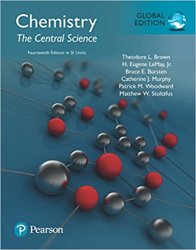
Название: Chemistry: The Central Science in SI Units, 14th Edition
Автор: Theodore L. Brown, H. Eugene LeMay, Jr., Bruce E. Bursten, Catherine J. Murphy, Patrick M. Woodward, Matthew W. Stoltzfus
Издательство: Pearson Education
Год: 2018
Формат: PDF
Страниц: 1198
Размер: 41.35 МБ
Язык: English
Unrivaled problem sets, notable scientific accuracy and currency, and remarkable clarity have made Chemistry: The Central Science the leading general chemistry text for more than a decade. Trusted, innovative, and calibrated, the text increases conceptual understanding and leads to greater student success in general chemistry by building on the expertise of the dynamic author team of leading researchers and award-winning teachers.
For courses in two-semester general chemistry.
New Features
How To features offer step-by step guidance for solving specific types of problems such as Drawing Lewis Structures, Balancing Redox Equations, Naming Acids, etc. These features, with numbered steps wrapped by a thin rule, are integrated into the main discussion and are easy to find.
SmartFigures walk students through complex visual representations, dispelling common misconceptions before they can take root by animating them into a continuous process rather than being forced to rely on discrete time points. Students are given answer-specific video feedback from the author team that validates their correct response or helps them get back on track by understanding why they were wrong, often revisiting the animation in a way designed to aid them in overcoming their misconception.
A Closer Look features have been updated to reflect recent news and discoveries in the field of chemistry, providing relevance and applications for students. End-of-chapter questions often give students the chance to test whether they understood the concept or not.
Enhanced art creates clarity and provides a cleaner more modern look with details that include white-background annotation boxes with crisp, thin leaders plus richer and more saturated colors in the art, and expanded use of 3D renderings.
Annotations offer more detailed explanations; new leaders emphasize key relationships and key points in figures.
Before/after photos now more clearly show characteristics of endothermic and exothermic reactions. Added reaction equations connect the chemistry to what’s happening in the photos.